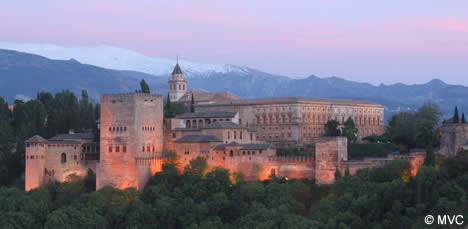
Tower of Comares
The two great Nasrid palaces which have come down to us intact are popularly known as the Tower of Comares and the Courtyard of the Lions. But the Moors knew them for the father and son who built them: respectively, Yusuf I and Mohammed V, whose reigns roughly correspond to the first and second halves of the 14th century.
The name Comares comes from the Arabic word camariyya, which means stained glass, for the coloured panes which once adorned its windows but were blown out by an explosion in a powder-house below on the river bank, in the 16th century.
Perhaps the most disconcerting thing about a Moorish palace, from a Western point of view, is that one does not enter through a great, ceremonial gate but, rather, by means of a discreet, lateral passageway, harkening back to the desert people whose tents had to be protected from the wind and sand. Although the entrance to the palace of Comares is framed in one of the most beautifully patterned walls in the Alhambra, it seems modest and small compared to the monumental scene which lies at the end of its tunnel-like corridor.
The great crenellated tower contains the Throne Room, or Hall of Ambassadors, where the Sultan received his official visitors.
Room of the Ship
First we cross a long, narrow room called the Sala de la Barca, which means, in Spanish, the Room of the Ship. The traditional explanation is that the ceiling resembles the hull of a sailing vessel, but the real reason is the similarity between the Spanish word for ship - barca - and the original Arabic, baraka, which means blessing - a word which, it seems, is inscribed repeatedly on its walls in praise of the king who built the room. The curious niches on either side of the archway were for water jugs, so that the visitors could moisten their lips before approaching the Sultan with their petitions. The wooden ceiling is a reconstruction - the original was destroyed by fire a century ago.
The antechamber of the Throne Room is called the Sala de la Barca, in English, the "Room of the Ship", a name which is customarily explained by the long, hull-like shape of the inlaid wooden ceiling. But it is the result of another misinterpretation. The Spanish confused the Arabic word for "blessing" - pronounced BARaka - with their own barca, ship. It was called Room of the Blessing because its walls are inscribed with words which commend the Sultan who built the room to God.
Two interesting details catch our eye as we step through the elaborately carved arches which separate this room from the great tower itself. On either side are exquisitely fashioned niches, where jugs of fresh water were placed for the visitors to wet their lips.
And in the recess to the right, a step further on, we glimpse the exquisite interior of a tiny mosque, where the Sultan could withdraw to pray.
Hall of Ambassadors
Each time I walk through this antechamber and set foot in the great square hall, with its cavernous domed ceiling of painted cedarwood, inlaid with a geometrical representation of the seven paradises of Islam, I get a special frisson. Once more, it is not only impressive from an architectural standpoint, with the austerity of its forms and proportions, but also for the setting in which it stands, overlooking the dazzling white city on the hill across the valley.
The bay windows of the great vaulted room before us were once glazed, sending streams of colour into the shadows. The Sultan and his vizirs would sit in these alcoves, surrounded by an aureole of light, when they received visiting dignitaries. All of these windows were destroyed by the explosion of 1590, and since replaced with wooden latticework.
The smaller, upper windows are filled with a delicate plaster openwork, illuminating the tapestry-like relief patterns on the walls.
The greatest of the many marvels of this unique room is, undoubtedly, the domed ceiling, with its wooden inlay representation of the Islamic universe. The Moors were masters of this kind of encrustation, which is known in Granada as taracea and mass-produced in the form of boxes and table tops for sale in the souvenir shops around the Cathedral.
Next page > Patio of the Lions
Buy your copy of - Granada, City of My Dreams
 Granada, City of My Dreams: An Historical and Artistic Guide to Granada and its Moorish Palace the Alhambra
Granada, City of My Dreams: An Historical and Artistic Guide to Granada and its Moorish Palace the Alhambra
This itinerary was written for Andaluca.com by Lawrence Boheme author of “Granada, City of My Dreams”. For, what fascinates us about this universal city is not only its monuments but its marvellous story, “the encounter between Moor and Christian, gypsy and Jew, medieval and Renaissance, glistening snow and Mediterranean sun. Lawrence Bohme, poet, illustrator and curious traveller, has filled these pages with luminous descriptions and drawings, the culmination of forty years of wanderings through the palaces and labyrinths. Amazon.co.uk or Amazon.es



